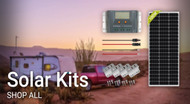SOLAR PANEL INSTALLATION GUIDE
6th Oct 2021
Solar panel installation
More Americans each day are transitioning towards renewable energy sources and 9 times out of 10, they choose solar. On the path to reducing your carbon and energy costs, one factor you are not likely to get around is the DIY installation of your solar panel configuration. If you’re considering the use of solar and possibly switching your home and vehicle to a solar setup, then we highly suggest you continue reading to get a better understanding…
So what exactly is your first step?
Designing your first DIY solar panel installation can help you identify the challenges you might face and gives you the opportunity to configure your system accordingly before going fully live with solar. Prior to the installation, you will need to design the size of your system based on your needs and the space that’s available. Having a finite amount of space and thoroughly measuring and verifying the sizes of the panels will save you time in the long run.
Installing on solar on your rooftop is much more than fixing the panels on a rack mounted to the roof. It requires thorough research on weather conditions, the amount of direct sunlight hours in your location, the amount of energy you could produce and lastly, the title angle of your rooftop. Adding batteries to your configuration will boost your energy input since the batteries can be used as a backup or emergency energy source. Furthermore, calculating your daily average energy usage will be very helpful when designing your solar setup.
Some would argue that the design stage is often the trickiest and most time-consuming step in the whole installation process. Ultimately, the amount of space available to you, the complexity of your system configuration, and the total cost value will determine the ideal solar system for you.
CHOOSE your system
Once you have your blueprint ready, it’s time to choose the right products and components required to build your ideal solar setup. There are three types of solar energy systems, and the choice will depend on the one that best matches your design and needs.
Having an off-grid solar setup means your system is not be connected to the utility grid and therefore a battery pack is necessary to store unused energy in this type of solar system configuration.
If you’ve already started researching different DIY solar projects, you’ve probably come across some of these items:
· Solar panels
· Solar inverter
· Wiring and electrical supplies
· Mounting and racking equipment
· Battery systems
· Charge controllers
It's often easier to buy a solar kit rather than researching and purchasing all the components separately. Residential solar panel kitsare designed to promote an effortless install and eliminate the need to verify compatibility of each component.
Installation
One you have all the components needed, all necessary permits or approvals, you can then begin the installation of your panels. Each installation varies depending on your preferred setup; however, we have outlined the basic installation steps below:
· Check your roof and ensure any shingles or tiles are correctly attached.
· Install solar panel racking and mounting.
· Install the solar panels on the leveled racking or mounting.
· Connect your inverter to the panels to convert the energy into current system.
· Inspect the installation.
· Connect to your main electrical board.
HOW MUCH DOES IT COST TO INSTALL SOLAR PANELS ?
According to research from the EnergySage Solar Marketplace, the average cost of installing solar energy is $16,860. Design, installation, and labor costs contribute to about 10% of the total bill. These average costs are calculated before applying incentives and rebates, which can have considerable savings.
Solar systems qualify for several rebates, tax credits,and incentives across different states. These incentives can significantly reduce the final costs of installing a solar energy system.
It’s important to remember that a solar setup is a long-term investment which will outperform and pay itself off over time. It's worth spending the money upfront on quality equipment and installation so you can enjoy the benefits and return on your investment in the long run.
Is it cheaper to build your own solar panels? Absolutely! DIY is usually the more affordable option when it comes to any renovation project. Newpowa provides DIY friendly solar kit solutions which includes all the necessary components and accessories designed to fit various situations. Ranging from large projects to smaller setups, solar panels are an excellent solution to a cleaner energy source.
CONCLUSION
Choosing solar power is highly recommended and a rewarding decision to make. By installing solar panels, you can reduce carbon emissions and lower your electricity bill. Switching to solar provides a pathway to increase our energy independence and live an adventurous lifestyle ‘off the grid’.
